Answer these simple questions and we will find you the BEST prices
Which type of solar quotes do you need?
It only takes 30 seconds
100% free with no obligation

Get Free quotes from insulation specialists near you

Save money by comparing quotes and choosing the most competitive offer

The service is 100% free and with no obligation
- GreenMatch
- Insulation
- Shed Insulation
- Shed Floor Insulation
Shed Floor Insulation: How to Install, Best Materials & Costs

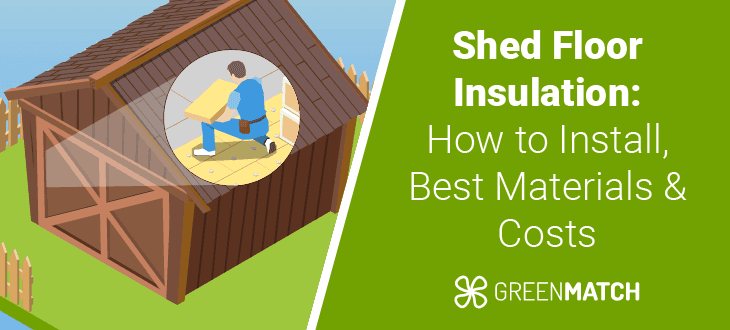
- Shed floor insulation typically costs around £105 per m2, but prices vary based on shed size and the materials used.
- Insulating your shed is a cost-effective solution to regulate temperature, control moisture, and extend its lifespan.
- While grants don’t cover shed insulation, professionals can help you budget effectively and may offer finance schemes to reduce costs.
With over 9.6 million sheds across the UK, sheds are an essential part of many homes, used for everything from storage to workshops or even home offices. While options like shed roof insulation and wall insulation can improve a shed's energy efficiency, these solutions can be quite costly.
One of the most affordable and practical ways to insulate your shed is through shed floor insulation. Not only does it help regulate temperature, but it also protects against moisture, making your shed more comfortable and durable year-round. In this guide, we’ll explore the benefits of insulating your shed floor, materials to consider, and how to do it yourself or with professional help.
Ready to insulate your shed floor? Working with a specialist ensures you get the right solution for your needs and budget. Finding one can be time-consuming, but GreenMatch makes it easy. We connect you with up to four free quotes from top insulation experts in your area. Fill out our 30-second form to get started. Click below to learn more.
- Describe your needs
- Get free quotes
- Choose the best offer
It only takes 30 seconds



Why insulate a shed floor?
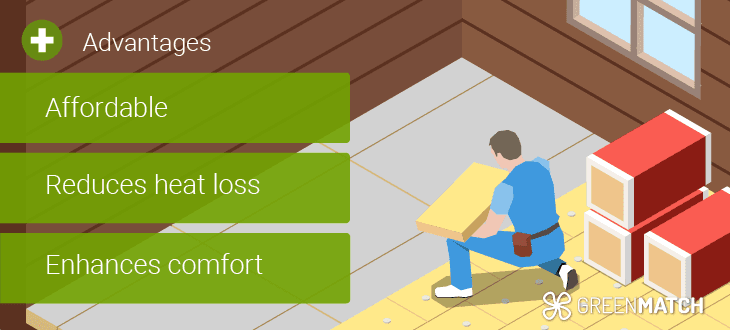
Shed floor insulation is one of the cheapest ways to insulate a shed, providing numerous benefits at a low cost. First, it enhances comfort by maintaining a stable temperature, keeping the space warmer in winter and cooler in summer, making it ideal for hobbies, storage, or as a workspace.
Beyond comfort, shed floor insulation improves energy efficiency by reducing heat loss, lowering the need for extra heating or cooling, and saving on energy costs. It also controls moisture, preventing dampness from rising through the floor and protecting tools and materials from rust or mould.
Proper insulation helps protect the shed from rot, mould, and structural damage by minimising moisture and temperature fluctuations. While a typical wooden shed lasts around 8 to 10 years, insulation can extend its lifespan, ensuring your shed stays in good condition for much longer.
Affordable and easy to install, shed floor insulation is a cost-effective way to increase comfort, energy efficiency, and the durability of your shed, making it more versatile for various uses.
How to insulate a shed floor
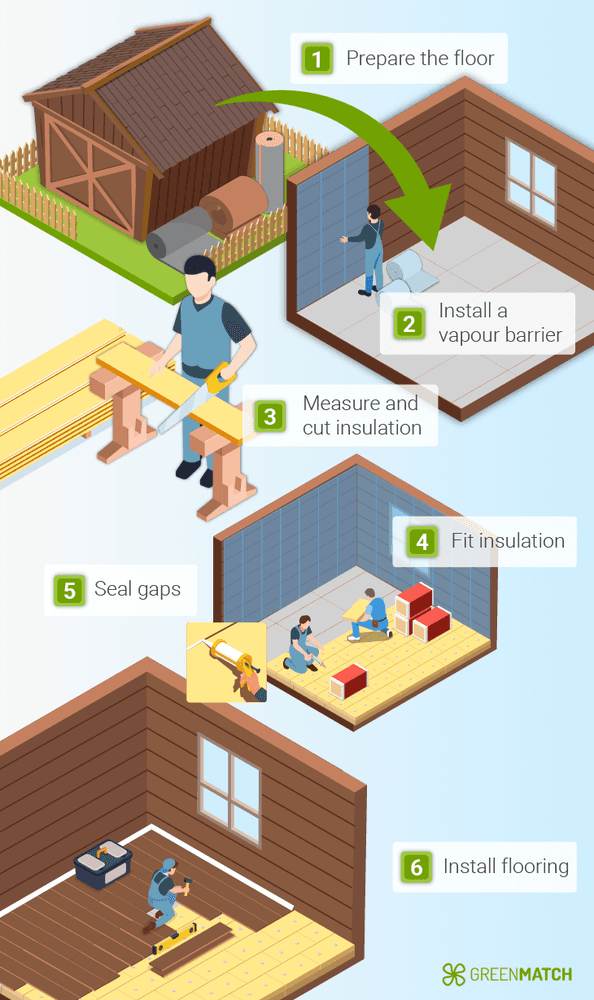
Shed floor insulation can either be a DIY project or completed by professionals. Either however, requires careful planning and an understanding on how to insulate a shed floor.
1. Choose the type of insulation: Several insulation materials are suited for shed floor insulation, choosing one depends on your preferences such as thermal efficiency and budget:
- Rigid foam boards
- Spray foam
- Mineral wool
- Fibreglass
After you have selected the type of insulation it is essential to gather all the necessary tools and equipment for a successful insulated shed.
- Plywood or OSB boards for flooring
- Vapour barrier (for moisture control)
- Tape measure
- Utility knife or saw
- Adhesive or construction glue
- Nails or screws
- Drill or screwdriver
- Sealant or foam spray (for gaps)
2. Prepare the floor: Ensure the shed floor is clean and dry. Remove debris and check for gaps or damage, as insulation will be effective only if the base is in good condition.
3. Install a vapour barrier: A vapour barrier is essential in damp areas to prevent moisture from rising through the ground and affecting insulation. Lay it across the entire floor, secure with tape or adhesive, and ensure there are no gaps in coverage.
4. Measure and cut insulation: Measure the floor dimensions and cut your insulation boards or batts accordingly. This cannot be achieved with spray foam insulation which must be applied by a professional.
5. Fit insulation: Place insulation boards snugly between joists or directly on the floor, ensuring no gaps. Secure with adhesive or glue to maximise effectiveness.
6. Seal gaps: Use foam spray or sealant to fill any gaps around the edges of the insulation boards and where they meet the walls of the shed. Proper sealing ensures no air or moisture can enter and compromise the insulation.
7. Install flooring: After securing insulation and sealing gaps, install plywood or OSB boards as the new floor. Screw or nail them securely.While DIY shed floor insulation is possible, hiring a professional ensures the best results. Professionals choose materials, address issues, and install vapour barriers correctly. GreenMatch connects you with local specialists and offers up to four free, no-obligation quotes. Fill out our 30-second form to learn more.
- Describe your needs
- Get free quotes
- Choose the best offer
It only takes 30 seconds



Best insulation for shed floor
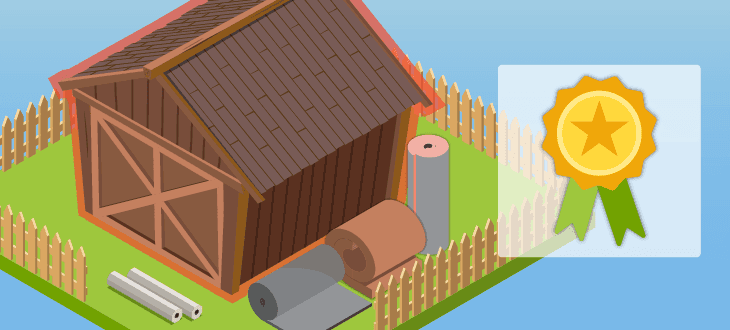
Choosing the right material for shed floor insulation is essential for comfort, energy efficiency, and moisture protection. Here are some of the best materials used for insulation:
- Rigid foam boards (XPS or PIR): These are top choices due to their excellent thermal resistance and moisture protection. Easy to cut and install, they fit between joists or can be laid directly on the floor, offering reliable insulation.
- Mineral wool: Known for its fire resistance and soundproofing, mineral wool provides good thermal insulation when combined with a vapour barrier. It's suitable for colder climates, though less moisture-resistant than foam boards.
- Fibreglass: A budget-friendly option, fibreglass offers decent insulation but requires a vapour barrier to protect against moisture. It's best for dry areas or elevated sheds.
- Expanded polystyrene (EPS): Affordable and durable, EPS is ideal for sheds in damp conditions. It’s lightweight but strong enough to support heavy objects.
- Spray Foam: While great for sealing gaps, spray foam is less practical for large, flat shed floors due to application difficulties and higher cost. It's better suited for walls or irregular spaces.
These materials balance insulation, moisture control, and ease of installation, making them the best options for shed floors.
Shed floor insulation cost in the UK
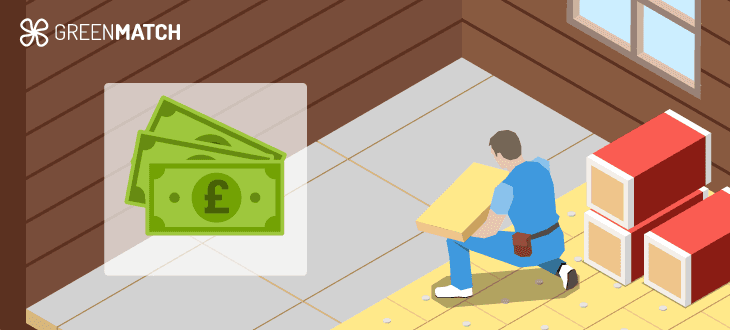
Insulating a shed floor is significantly lower than the total cost of fully insulating a shed. While full insulation for a shed can range from £670 to £1600, shed floor insulation is much more affordable.
Typically, shed floor insulation costs around £105 per m2. However, since the floor area is smaller compared to the walls and roof, the price of insulation for just the floor will be much lower. For example, an 8x8 shed has approximately 6 square metres of floor space, meaning the floor insulation cost would be considerably cheaper than the total shed insulation.
Focusing solely on the floor can significantly reduce costs while improving comfort and energy efficiency. Remember, the final price will depend on the insulation material you choose and whether you hire a professional or tackle the project yourself.
| Material | Average cost per m2 |
|---|---|
| Fibreglass | £10 |
| Polystyrene (EPS) board | £10 |
| Polyisocyanurate (PIR) board | £12.50 |
| Polyurethane (XPS) board | £21.50 |
| Mineral wool | £13 - 17.50 |
| Spray foam | £21.50 or more |
Pros and cons of shed floor insulation
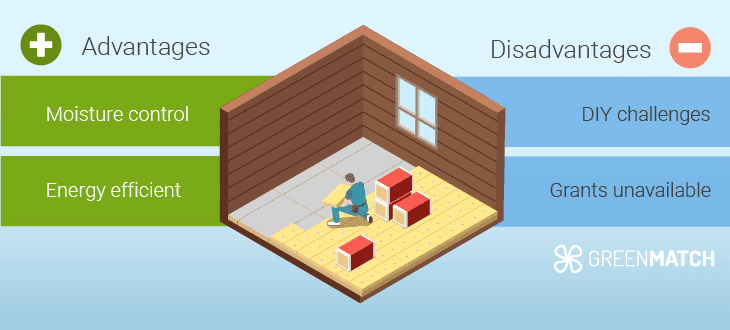
When considering insulation for your shed, it's essential to weigh the benefits and drawbacks. Here are the pros and cons of shed floor insulation:
Pros
- Improved comfort: Insulating your shed floor helps regulate temperature, keeping the space warmer in winter and cooler in summer, making it more comfortable for use year-round.
- Energy efficient: Insulation reduces heat loss, potentially lowering heating costs if your shed is used as a workspace or hobby area.
- Moisture control: Proper insulation, combined with a vapour barrier, can prevent dampness, protecting stored items from mould, rust, or decay.
- Extended shed lifespan: Insulating the floor helps protect the shed structure from moisture and temperature fluctuations, prolonging its life.
Cons
- Initial cost: Installing shed floor insulation requires an upfront investment, and while it’s more affordable than full shed insulation, costs can still add up depending on the materials and labour involved.
- DIY challenges: While shed floor insulation can be done as a DIY project, improper installation may reduce its effectiveness, especially if gaps aren’t sealed or the vapour barrier isn’t installed correctly.
- Grants for insulation: While there are grants for insulation in the UK, they typically don’t cover shed insulation. This means you'll likely need to finance the project yourself.
Although grants for insulation don't necessarily apply to sheds, seeking professional help can guide possible finance schemes to offset costs. At GreenMatch, we connect you with local insulation specialists who can tailor solutions to your needs and budget. Fill out our 30-second form to receive up to four free, no-obligation quotes. Click below to learn more.
- Describe your needs
- Get free quotes
- Choose the best offer
It only takes 30 seconds



FAQ
To protect your shed floor from moisture, install a vapour barrier beneath the insulation and ensure the floor is sealed properly to prevent dampness from rising through the ground.
The best materials to insulate a shed floor are rigid foam boards, which offer excellent thermal resistance and moisture protection.
Expanding foam can be used under a shed floor to fill gaps, but it’s generally less practical for large, flat surfaces compared to other insulation materials.
Yes, a vapour barrier is essential in a shed to prevent moisture from rising through the floor and damaging the insulation or structure.

Caoimhe is an experienced content writer and researcher who is passionate about providing accessible information to every reader. With a background in English literature and Sociology, she combines the two disciplines to create cohesive, well-thought-out, and well-informed pieces.
We strive to connect our customers with the right product and supplier. Would you like to be part of GreenMatch?

- Describe your needs
- Get free quotes
- Choose the best offer
It only takes 30 seconds



